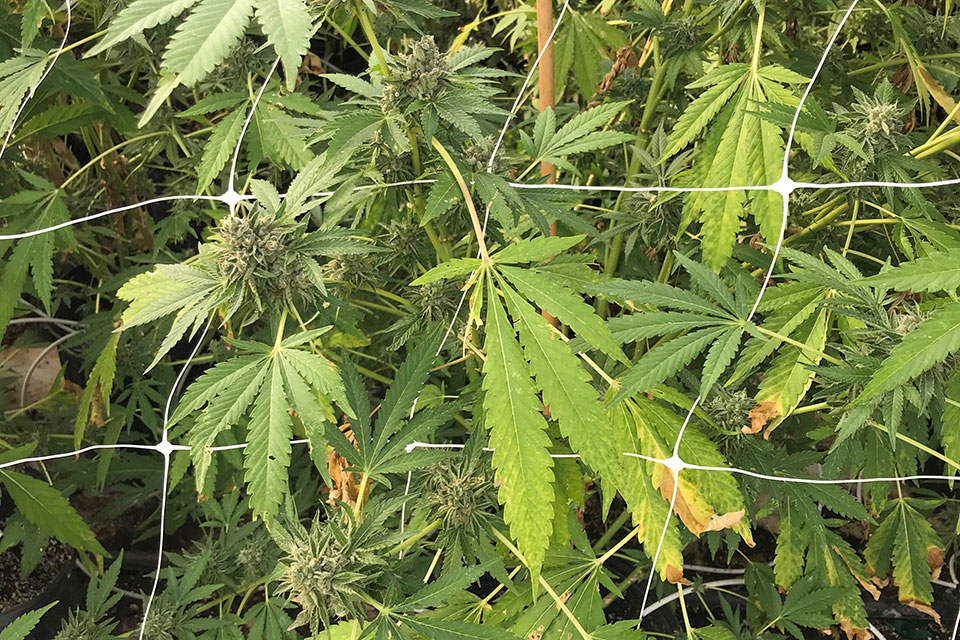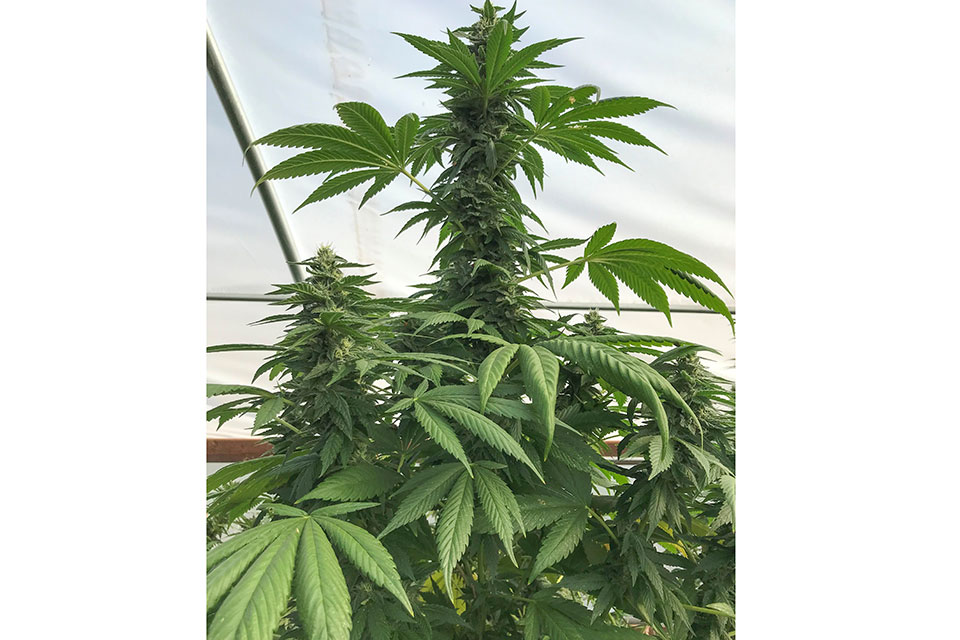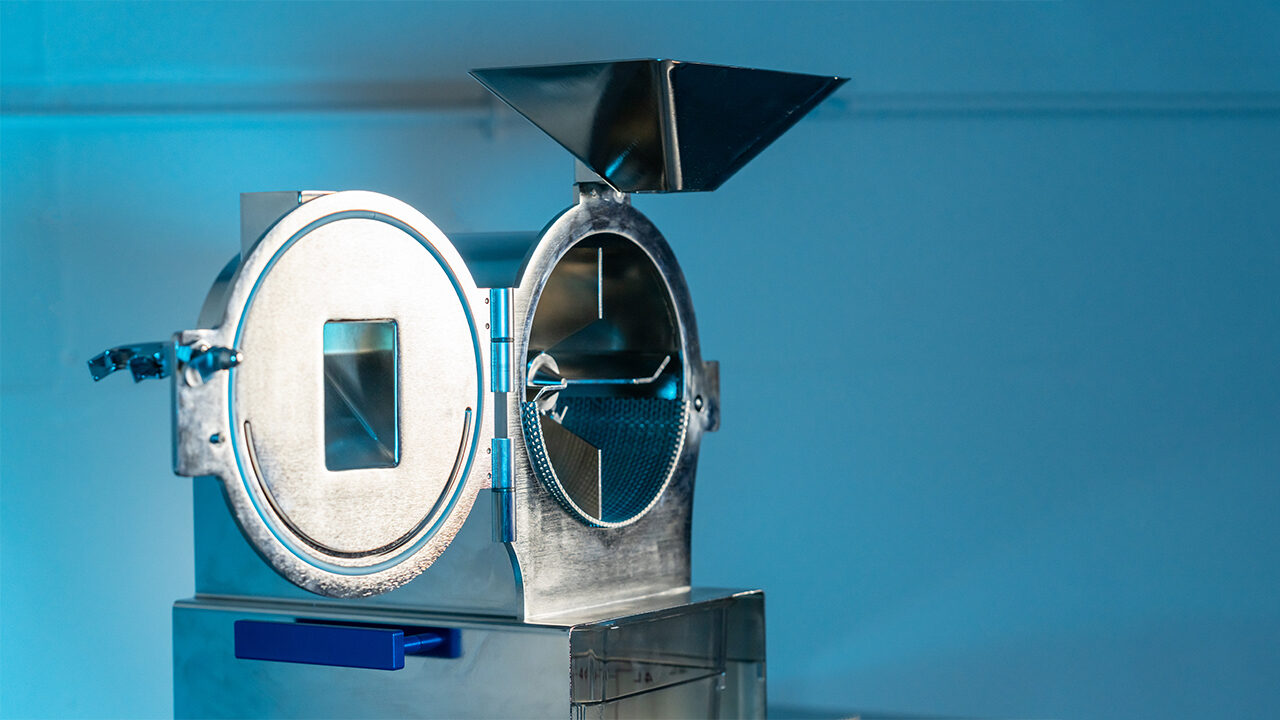A Physiological Approach to Nutrition in Flowering Cannabis

When nutrients available outside to the roots are not sufficient, the cannabis plant recycles inside nutrients from old leaves to feed new, developing flowers. Photos: Shiv Reddy
Editor’s Note: Last month, Dr. Reddy looked at questions to consider when addressing cannabis nutrition during the vegetative stage, including nutrient formulas, ratios, concentrations, frequency, and more. This month he addresses nutrition at the flowering stage.
During long light hours of vegetative phase, cannabis is receiving a lot of photon power and wants nutrients to grow fast. With good nutrition, you can see the thin, divided leaves emerging fast and the number of leaflets per leaf increasing, then growing wide — all to capture more light. You can press on the gas or brake pedal of the feed level to grow and establish a plant size you want. With this growth, the branches established now would have a bearing on the flowering and yield potential later.
As you Shift Cannabis to Short Light Period for Flower Buds, Would the Same Feeding Continue?
Yes. After shifting to short light period, cannabis bursts into a growth spike. In fact, cannabis puts on most of its mass during this time. Even after shifting, cannabis continues to grow fan leaves for a couple of weeks, and then grows inflorescences. Cannabis produces most of its THC and CBD on bracts and tiny leaves that are amidst these inflorescences. The bracts are leafy, and thus share similar physiology and nutrition requirements as leaves. So there is no reason to deviate from the nutrient formula. During this time, cannabis needs adequate nutrients not only for the rapid growth of inflorescences, but also for accumulation.
Would Flushing Before Harvest Impact Cannabis Buds?
When you flush out nutrients from soil, cannabis senses the deficient nutrient condition in the soil and tries to restore the deficiency by moving nutrients from its older, fan leaves to flower buds to meet the nutrient demand from flowers. That’s why, after flushing, you often see premature yellowing and senescence of older leaves and little impact on nutrients in buds. Cannabis always tries to ensure that its growing parts have nutrients and in order to so, regulates the movement of nutrients inside.
Can Cannabis Regulate Nutrients Within Itself?
When extra nutrients are available in soil, cannabis takes in some extra nutrients as a precaution and reserves them for drawing during any future shortage. Because of these reserves, you don’t see cannabis showing deficiency symptoms immediately after you stop supplying a nutrient. After the reserves are over, if nutrients are still not available to roots, cannabis moves nutrients from old leaves to meet the demand from new leaves and flowers, so it can continue to grow and complete its life cycle. In fact, if you let cannabis buds go to seeds, the altruistic mother cannabis sacrifices herself by diverting nutrients from everywhere to seeds, so her children face no compromise in their development. This recycling of nutrients takes place through phloem tubes inside cannabis. However, micronutrients don’t move well in phloem. And just a few ppm of calcium clogs phloem tubes. Also, movement of nutrients from old parts is not quick or sufficient enough for normal growth of cannabis. Therefore, you want to ensure cannabis has adequate access to nutrients in soil, which move via xylem pipe.
What About Phosphorus or Potassium Boosting Blooms?
Cannabis requires concurrence of all nutrients to synthesize its cells, including flower cells. Cannabis does need phosphorus for flowers, but extra phosphorus doesn’t boost blooms. If you give extra phosphorus and potassium, while nitrogen is short, cannabis interprets the condition as nitrogen shortage and restricts its growth to meet the lower nitrogen level. The concept of extra potassium during flowering comes from tomato nutrition. When tomatoes and other watery fruits are growing, they take in potassium to make their cells salty so they can pull in water and swell. Even then, only the proportion of potassium taken up by the plant changes and the original nutrient formula would still have adequate potassium to meet potassium demand without a need for change in the formula.

Corn cob-like colas demand high nutrients for their bulky growth as well as for an inherent reserve for transfer to seeds, so make sure proper nutrients are available to cannabis plants during flowering.
What About the Use of Calcium-Magnesium Feeds on Cannabis?
Calcium deficiency in cannabis due to absolute shortage of calcium in soil is rare. Rather, calcium deficiency is due to either the original soil being loaded with potassium or sodium, or overloading by the grower. Calcium, potassium, and sodium are chemically related — think of them as sister nutrients. High level of one sister nutrient like potassium depresses the entry of another sister nutrient like calcium into cannabis. So, maintain proper levels of each sister nutrient in the soil. Another reason for calcium deficiency is high humidity in the grow room. Calcium enters cannabis passively along the transpiration water stream. High humidity leads to low transpiration — thus low calcium flow — especially to the fast-growing inflorescences, which don’t have large transpiring area like leaves. Further, the tight cluster of buds cause stagnant air and exacerbate high humidity within large colas. So instead of applying more calcium to the soil, increase air movement over the buds to increase transpiration and calcium flow. You could also increase humidity during the night to push calcium to the growing buds. Magnesium to some extent is similar to calcium.
How Does Nutrition Influence Cannabinoid Synthesis by Cannabis?
Cannabinoids are plant defense chemicals and are toxic to cannabis plants, too. That’s why cannabis synthesizes cannabinoids in the head of the trichome. The enzymes that synthesize cannabinoids are produced in the trichome itself. However, the precursors or raw materials and energy for the synthesis of cannabinoids may be generated in the flower bracts, as bracts are green and can photosynthesize. Or, they may be imported from leaves. This process of cannabinoid synthesis is a high metabolic activity, for which cannabis plants require adequate nutrition.
Can Cannabinoid Percentages Be Increased With Specific Nutrients?
This reminds me of a CSI kind of research done to determine whether THC or CBD percent in seized cannabis could be traced to the nutrient levels of soils in Afghanistan, Mexico, etc. There was no such relationship, indicating cannabis strain — rather than cannabis nutrition — tightly controls cannabinoid levels. You do hear of increasing cannabinoid levels to some extent by imposing nutrient stress. But this is a complex subject. Nutrient stress may modify the profile of 100 different cannabinoids in 10 different ways. Nutrient stress may also suppress growth, so you may get more potent but smaller buds. A more reliable strategy is producing more cannabinoid quantity through bigger flower mass or weight by proper nutrition.
Finally, What About pH Control of Cannabis Soil?
pH of soil is important, but you don’t have to spend 12 hours a day in your growing room measuring and keeping a perfect pH of 6.2. Cannabis tolerates and grows quite well between pHs of 5.5 and 6.5 as long as nutrients are available. The direct effects of pH on cannabis root growth are small.










